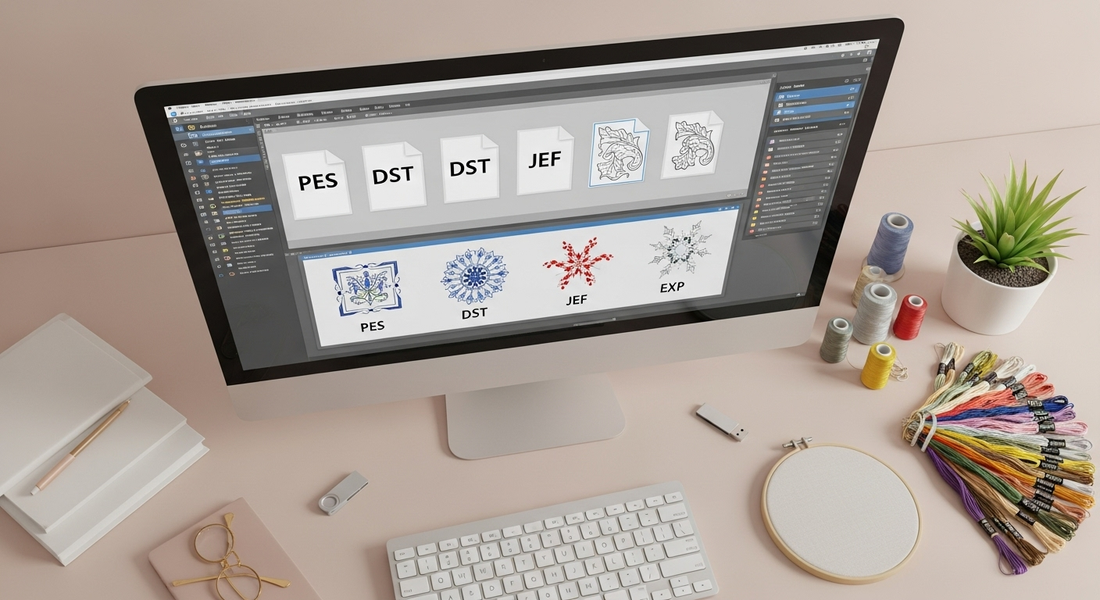
So... What’s the Deal with DST, PES, and All Those Embroidery File Formats?
Share
Let’s be honest—we’ve all been there. You find a design you love, you’re excited to stitch, you load it into your machine… and bam: error message. “Unsupported file type.” That’s usually the moment most of us first learn: embroidery machines can be pretty picky about file formats.
So what are these file types anyway? Think of them like stitching blueprints. Each one tells your machine how to move the needle—where to go, how long the stitch should be, when to stop, and in what order to do everything. But here’s the twist: not all machines speak the same file “language.”

The Usual Suspects: DST, PES, and Friends
- PES files are what Brother and Baby Lock machines understand.
- DST is more of an industry standard and works on many commercial machines.
- JEF is for Janome.
- VP3 plays nice with Husqvarna and Pfaff.
- And there are others, too (yes, it gets a little messy).
That’s why, before you even fall in love with a design, it’s a good idea to check if the format matches your machine. Otherwise, you’ll be stuck googling file converters at 11 PM when all you wanted was to stitch a cute cactus.
- The brand and model of your embroidery machine
- The software used to create or edit the design
- The type of stitch data they contain (vector, object-based, or stitch-by-stitch)

Most Common Embroidery File Formats
Here are the most widely used formats and the machines or programs they are associated with:
PES (.pes) – Brother / Baby Lock
- One of the most popular formats.
- Compatible with Brother and Baby Lock machines.
- Can include color, stitch, and hoop information.
DST (.dst) – Tajima / Commercial Machines
- An industry-standard format for commercial embroidery.
- Works on many multi-needle and industrial machines.
- Stores basic stitch data but limited in color detail.
EXP (.exp) – Bernina / Melco
- Common with Bernina and Melco machines.
- Often paired with a separate color chart file.
JEF (.jef) – Janome
- Used by Janome machines.
- Stores both design layout and stitch data.
VP3 (.vp3) – Husqvarna / Pfaff
- Works with high-end Husqvarna Viking and Pfaff models.
- Supports detailed stitching and color info.
XXX (.xxx) – Singer
- Native format for Singer embroidery machines.
- Less common but still used in some home embroidery setups.

Native vs. Stitch-Only File Types
It’s also helpful to distinguish between "native" and "stitch-only" files:
- Native Formats (e.g., EMB, ART, OFM): Created and edited in embroidery software; retains object data and is editable.
- Stitch-Only Formats (e.g., DST, PES, JEF): Finalized instructions for the machine to read and stitch; not easily editable.

How to Convert Between Formats
To ensure your design works with your machine, you may need to convert file formats. Many embroidery software programs can help with this:
Popular Conversion Tools:
- Embrilliance Essentials
- Wilcom Truesizer (free version available)
- SewArt
- Hatch Embroidery Software
🛠️ Tip: Always check your machine’s user manual for supported file types. Sending the wrong format can result in a failed stitch-out or cause software errors.
Organizing Your Design Library
As your collection of digital embroidery files grows, good file management becomes crucial. Here’s how to stay organized:
- Use folders by file type or machine compatibility
- Rename files with project-specific labels
- Keep a backup on cloud or external storage
- Print or save PDFs of color charts and stitch info
Conclusion
Understanding embroidery file formats is key to working efficiently and avoiding compatibility issues. By learning which formats your machine supports and how to convert between them, you’ll unlock a wider world of digital designs and streamline your workflow. Whether you're using PES, DST, or any other format, being format-savvy makes all the difference in your embroidery success.